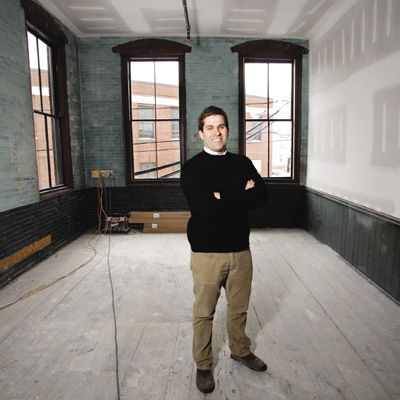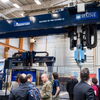A Biddeford architect hits upon a way to increase revenue and revive a downtown
Among the current fixtures on Main Street in Biddeford are several banks, City Hall, a theater, old standbys like Reilly's Bakery and Youlland's Jewelers, as well as newer establishments like tattoo parlors and a few restaurants that have moved in over the last few years. Unfortunately, it's also home to approximately 10 empty storefronts.
Together with well-known local businessman David Flood, architect Caleb Johnson hopes to change that. The two founded Thread, a for-profit development company with the intent of revitalizing Biddeford. Starting with their work on 265 Main St., a very visible building across from McArthur Library and next to a municipal parking lot, they hope to create a wave of reinvigoration that will spread all the way from Elm Street to the bridge. At the very least, when completed, this project should fill 20% of those empty storefronts.
Johnson's firm, Caleb Johnson Architects, has been involved in the local community from the day it opened in 2003, designing a park on the corner of Elm and Main Streets, as well as one on Washington Street. He's had his eye on 265 Main St. for years and was able to buy it out of foreclosure with Flood for $275,000 in 2010.
What's so special about the project, he says, is that it comes at a time when his firm is experiencing incredible growth while many in design, building and construction struggle to find work. The growth in the last two years alone, he says, has been almost dizzying. He attributes a great deal of this success to a design-build philosophy that allows his firm to carve out a larger fee than it would if he only offered architectural services.
Mainebiz recently sat down with Johnson to talk architecture, business and downtown Biddeford.
Mainebiz: Why did you decide to become an architect?
Johnson: My first love since I was a kid was making things. That turned into a love of art when I was in school. Then the practical side of me, the business side of me, kicked in and said, “You can be an artist and an architect at the same time and then you don't have to be a starving artist.” It doesn't matter what you do to me, I'm still going to be making things every day, and so this profession fills that need. Even when I was working for another architect, I was constantly doing my own little real estate projects here in Biddeford and designing things and so on.
What kind of growth has your firm experienced in recent years?
Two and a half years ago, there were two people and our gross might have been $150,000. We topped a million this year [2011] and we're looking at $3 million next year [2012]. That's with design and build.
As we grow, we're really focusing on filling the positions that come open with the best talent that we can find. We feel that there's a lot of talent that's sitting on the bench, so if we're able to get in some people who previously weren't available, then that's great. Right now we're at seven employees. We have three registered architects, two intern architects, a construction manager and an office manager. We'll also be hiring a senior construction manager. That position's going to be hugely important over the next two to three years.
What I'm trying to do is be responsible with that growth so we won't have to make a big cutback if the projects slow down. But at the same time, we're going to keep servicing projects. The more projects we get out there with happy clients, completed buildings and signs on the street, the more it's going to solidify the growth that we've experienced over the last couple years.
Why do you think you're finding success in this economy?
I'm searching for the answer so that I can build on it. I think it has everything to do with flexibility in terms of the services that we're willing to offer. People need different services than they might have needed 10 years ago. Our priorities are different than they might have been 10 years ago.
Certainly, the fact that we've got construction expertise has helped make us busier now than we were then. It's going solid while some people are struggling, but we're experiencing growth that my instincts tell me is a little too fast, but at the same time, what am I going to do about it?
The design-build philosophy gives us a way to generate more revenue based on how we service our projects. If I'm just an architect, the only service I'm going to sell to you is design, so the most I'm going to earn on a $100,000 project is $6,000 to $10,000. If I've got an office of six people and a budget that's $800,000 a year, that's not going to work. What we're able to do is turn that $6,000 fee into $25,000. It's still not ritzy compared to the size we are right now, but also that means we can take a $200,000 project and get a $50,000 fee.
That allows us into smaller projects and smaller budgets where architects didn't used to sit. Normally, if you're doing a smaller renovation, your builder is your designer. We're bringing the benefit of people with master's degrees working on small projects and turning that into revenue that's profitable. That project delivery approach has driven our growth — and funded our growth.
Certainly our visibility in the local community also has a lot to do with our growth and our stability at the moment. We're very involved on many fronts in the local community, and that just helps. We don't just sit here in the office and hope the work comes to us. We're out there with our marketing efforts, with our hours and volunteering, with our involvement with community projects.
What challenges has your firm's growth posed?
I'd say it's only been in the last two years that I haven't had to worry about my paycheck at the end of the week. That's a new experience to me, but now that I'm hiring all these people and I see that I've got to make $50,000 to $60,000 a month, all of a sudden I'm back to the same situation.
So right now, I'm struggling with the business side of things starting to take up more of my day and more of my head space. That's fine because I like the business, but I can tell that as my career progresses, there's going to be a constant conflict between “am I a stinkin' businessman or am I an architect?” And if I'm not careful, I'm going to be all businessman and burn out.
But the biggest challenge will be not to get arrogant and think it will stay like this forever and get complacent.
Is a ‘design-build' philosophy unique or innovative for an architect?
It may be a stretch to call it innovative, but the way we're delivering projects to clients from beginning to end is not something that I've seen architects do before. I'm aware that there are other people who are doing it, but certainly in our geographic region I don't know of anybody who is.
Here's why I think it's working for us: There are a lot of renovations; people are being very careful with their money and they want a lot of bang for their buck right now. And they're seeing our work and they're realizing that they can get everything from design all the way through occupancy permitting and construction from one firm. They're seeing a lot of value in that.
How long have you offered design-build services?
We started in 2003, and one of the projects we did was a little design-build kitchen renovation where we actually ran the paintbrushes and whatnot on the project. And that was for the city manager of Biddeford at the time. So from the very beginning, we've had that design-build model. But the past two years, and the past year certainly, we've just had a wind at our back that's been hard to keep up with.
Why did you get involved with 265 Main St.?
It's been one of my favorite buildings since I moved to Biddeford in 2000. The whole second and third floors have been vacant for more than a decade before, probably since the '80s. I can't remember how long that storefront on the first level has been empty or whether it's ever had any solid business.
What are the plans for the building?
We've got a good community arts tenant in there (the nonprofit Engine), and we're working on a letter of intent with a Portland-based restaurant company to do a great restaurant downtown. That's huge for our building of course, but more important, if we get that restaurant, there will be a Portland- or Portsmouth-quality restaurant. Biddeford hasn't seen something like that since I don't know when. We've seen these startups that might cost $5,000 to set up a storefront, and all of a sudden, we're going to stick something in there that's a quarter of a million to set up a storefront. And nobody's seen that since I've been here.
What's the status of the project?
We were aiming at the end of January for completion, but I think we're well into February now. The big reason for that is because we think we've found a restaurant tenant on the first floor. That's requiring some changes on the second and third floors because we've got a lot of ductwork that we have to put in.
I fully expect that the first floor will be completely occupied with active tenants, which would be the biggest deal because that's always the hardest part. The second floor is already half occupied because it's going to be my office, and we'll also have four artists' studios, which we're in the process of showing. On the third floor, one of the units is already rented. We could rent those to anybody, but we're holding out those for artists who can live and work in the same space.
Beyond 265 Main, what is your vision for downtown Biddeford?
We created Thread to invigorate and revitalize the downtown through for-profit development. We're extremely active politically and we're extremely active with the nonprofits around Biddeford. Many of us are starting to visualize a draw for Biddeford because there is no real draw right now. You can go to Exchange Street to shop; you can go to Congress Street for the same thing and for arts and culture. Portsmouth has its draw and Dock Square has its draw. Right now, you go to downtown Biddeford to conduct your everyday business like banking and going to City Hall, those kinds of things. We're all about getting that thing to spread down the street, which is why we're doing [265 Main]. We'll be starting with Engine on the Renys building [which has been vacant since 2008] later this year, so it's working.












Comments